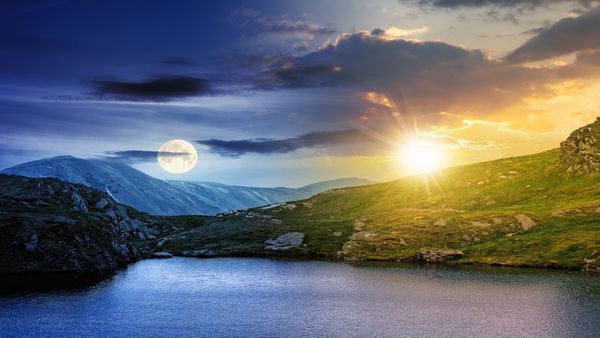Ecclesiastes was on to something. While an exuberant ephemerality is at the heart of the ancient book, its boiled-down truth is one we hum in our heads for good reason: for everything there is a season, a time for every matter under heaven.
And, if pressed to point to proof of the sheer genius at work in the cogs and the gears of creation, the faithful wheeling of the year would be my number one exhibit: the undulations of earth’s turning, the rhythms of shadow and light, heat and cold, the enlivening and the dying and all the tug and the pull and the paradox in between, that brings us the carousel of ever-shifting season.
More than anything it teaches me trust, with a chaser of awe.
The way we’re nearly at wit’s end, can’t take one more day of the gloom or the cold or the inferno, and then suddenly it starts to give way, a softening comes, the heavens shift, and we’re on to the next picture show. There seems a soulful omniscience ever on watch and at work — a hop, skip, and a jump ahead of little old worrying, wearying us. Rebirth is its constant; no wonder we’re brought to our knees.
Each season, in four quarter turns, brings forth its own headlines. There’s the yin and yang of spring, the season of exodus and resurrection, of equal parts heartbreak and magic. “The fizz and the roar of the land coming back to life again,” is how Robert Macfarlane brilliantly captured the vernal animations.
It’s a wonder reel that never ends, yet never truly repeats — a koan for the ages.
I often contemplate the geometries of time, how the year is not an inescapable circle, a shape that would get us nowhere, but rather it’s a spiral, and from one springtime to the next we’re never the same, always ascending, closer to the holiness we were meant to be — or so that’s the hope, anyway.
“The seasons are our Scripture text,” writes Celtic spiritualist Christine Valters Paintner. “This earth we are riding keeps trying to tell us something with its continuous Scripture of leaves,” echoes William Stafford, the late poet and pacifist. To the ancient Celts, the unfolding of the seasons read as “gospel without haste.”
What they’re saying, it seems, is that the sweep itself is where the whole sum lies, though each part is its own bottomless cache of wonder — sensory, yes, but spiritual too.
It’s symphonic beyond measure, the way the seasonal threads are woven, how one gives in to another, how each holds up another. No wonder poets and painters, all those who keep close watch, are drawn to its boundless variations, each a study of creation in motion, ever new, often timeless.
“Creation is here and now,” wrote Henry Beston, the naturalist and Yankee poet, in a letter to an old friend. “We are not living on a mechanism running down like a clock but on an earth sustained by an ever-creating, outpouring stream of the divine imagination.”
Take springtime, season of quickening, season of equal parts shadow and light — the very equation at its astronomical heart, the vernal equinox marking the fleeting moment when earth’s axis aligns directly with the sun, and the planet is neatly halved with equal allotments of light, and the sun shines squarely on the equator.
Emily Dickinson calls springtime “a sacrament,” and, as always, she nails it, certainly when you consider the dictionary definition of sacrament as “a means of divine grace.” Hard to think otherwise of the “trumpet call of the return of light,” as Beston saw it, or “the unsealing of the waters of earth,” come the warming-up months in winter’s wake.
I think of those stirrings from deep underground as part of the ablutions of springtime, the rinse of the in-rushing air when the staleness of winter is broomed out the door.
Springtime, when one minute the tenderlings are breaking through the Earth’s thawing crust and then — kebang! — the snows fall. It is the season for teaching resilience. It’s with a pang in the heart that we tiptoe out in the dawn, to dust the ice cakes and crystals off the furled petals of snowdrops and earliest daffodils.
And how can our souls not feel resuscitated when at daybreak the birdsong is limitless and cadenzas are flung from the boughs?
But, just as certainly, April’s tempestuous winds will topple the robin’s nest from the nook where it was wedged. To come upon a fallen mud-daubed construction, one now cradling orbs broken open, is to be pierced by the merciless pangs of the season of starting over again, with death an inevitable and unavoidable shard at the root of that proposition.
And so the year, in all its seasons, is a never-ending book of intelligence, divine intelligence, ever ancient and new. It is in these topographies of time, the geographies of wonder, the ones that come as we’re walking the year, that we stand our one best chance for intimate encounter with the Almighty, the Cloudmaker, the Heavens Opener, the One Who Puts Flight to the Wing.
I think of the words of Meister Eckhart: “God’s ground is my ground and my ground is God’s ground.” And so, too, time; be it taken in chapter or stanza — summer or autumn, winter or spring — or in the whole volume’s unspooling as inscribed in Ecclesiastes: a time to be born, a time to die; a time to plant, and a time to pluck up what is planted. A time to behold, a time for every blessing under heaven.










